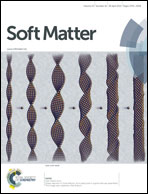Influence of temperature and organic solvents (isopropanol and 1,4-dioxane) on the micellization of cationic gemini surfactant (14-4-14)†
Abstract
The micellar properties of gemini surfactant, tetramethylene-1,4-bis(dimethyltetradecylammonium bromide) (14-4-14) in binary aqueous mixtures of isopropanol (IP) and 1,4-dioxane (DO) were investigated by tensiometric, conductometric and microcalorimetric methods in the temperature range of 298 to 323 K. The values of both critical micelle concentration (cmc) and degree of dissociation increase with increasing temperature and concentration of cosolvent. The energetics of micellization was determined from the temperature dependence of critical micelle concentration values. The standard Gibbs free energy of micellization (ΔG0m) was found to be negative and the negative value decreases with both temperature and concentration of cosolvent. The Gibbs free energy of micellization (ΔG0m) is mainly controlled by tail transfer free energy. The enthalpy of micellization obtained from direct calorimetry, Gibbs–Helmholtz equation and van't Hoff methods are presented and compared. Entropic contribution is found to be larger than the enthalpy and for all the systems, an enthalpy–entropy compensation phenomenon was obtained. Some interfacial parameters, e.g., Gibbs surface excess (Γmax), minimum area per surfactant molecule (Amin), surface pressure (Πcmc) were been calculated. The fluorimetric technique was used to understand the microenvironment of the solution under the influence of cosolvent. The micellar aggregation number of 14-4-14 in a binary mixed solvent was also determined from fluorimetry using pyrene as a probe. Two fluorophores, fluorescein and curcumin delivered the information of the peripheral region of the micellar interface and palisade region. The self-diffusion coefficients of the micellar media were evaluated using the cyclic voltammetry (CV) method. Such multi-technique investigation provides a new look into the role of solvation in micellization.


 Please wait while we load your content...
Please wait while we load your content...